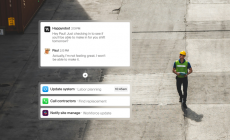-
AI startup Onton raises $7.5M to reinvent the way the world discovers and decides what to buy - November 26, 2025
-
Forklift Market Positions for Recovery as Confidence Expected to Build from 2026 - November 26, 2025
-
PROCare achieves 300% order capacity increase and 99% picking accuracy with Forterro’s ERP solution, Orderwise - November 26, 2025
-
DHL boosts operational efficiency and customer communications with HappyRobot’s AI Agents - November 25, 2025
-
STENA LINE TEAMS UP WITH CAMERA TELEMATICS TO DRIVE SAFETY IMPROVEMENTS AT IRISH SEA PORTS - November 25, 2025
-
Another design award for Toyota’s lithium-ion Traigo_i counterbalanced forklift - November 21, 2025
-
Stuut Technologies Raises $29.5 Million Series A Led by Andreessen Horowitz to Automate Accounts Receivable Work - November 20, 2025
-
INCREASED DIGITAL INVESTMENT REQUIRED TO KEEP PACE WITH 2026 CUSTOMS CHANGES - November 19, 2025
-
FULFILMENT SOLUTIONS FOR SPORTS MERCHANDISE: KEEPING OUR EYE ON THE GAME - November 19, 2025
-
COMPLEX, COSTLY & CONFUSING – THE END OF DE MINIMIS - November 19, 2025
Non-EDI users held up in the mail
Approximately 42% companies that do not use EDI, or use only a customer web portals, use post for exchanging documents. This is according to a survey of companies conducted this year for leading EDI company, Data Interchange, who also found that 27% use fax and 28% use a customer web portal. Email is the most popular method at 67%.
Companies using the ‘traditional’, non-EDI methods of exchange, such as post and fax, are losing out significantly, according to Colin Fisher, Head of Sales at Data Interchange. He explained: “Post, in particular, has a massive cost and time impact, both on the customer and the supplier, because it is a completely manual process.”
A GS1 UK white paper identified a £14 per order cost saving gained when using EDI compared to manual processes including phone, fax, post and email to order stock from suppliers. These cost savings are gained through the reduction in disputes caused by inconsistent data, reduced administration and paper work, faster moving stock and less compliance checks needed.
For further information contact info@datainterchange.com

































